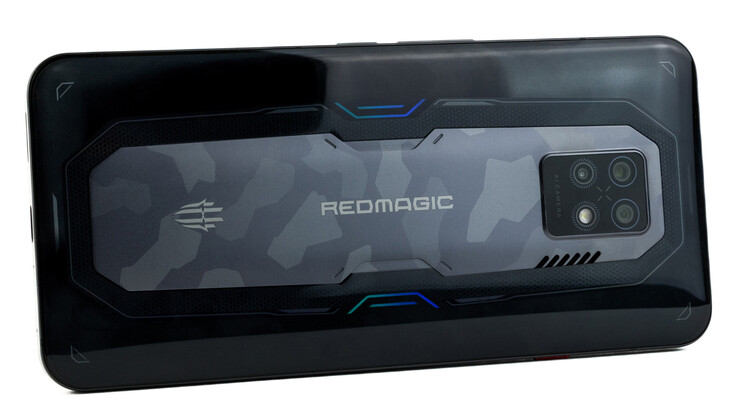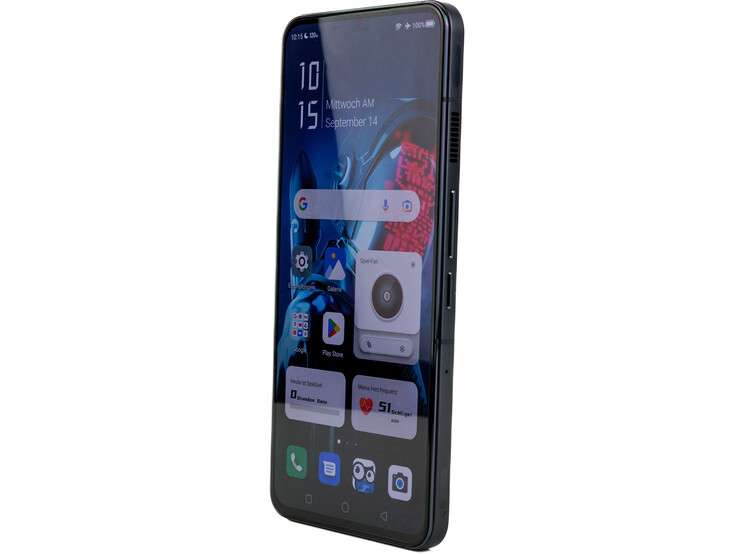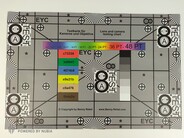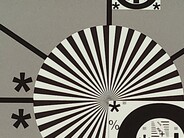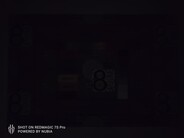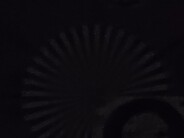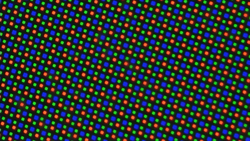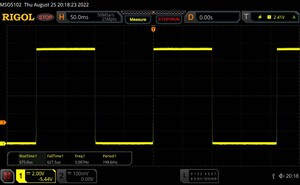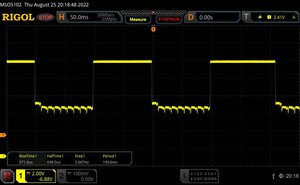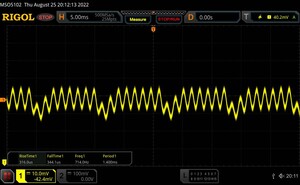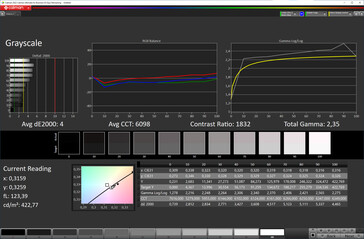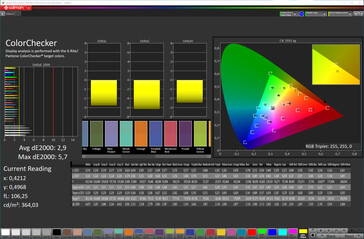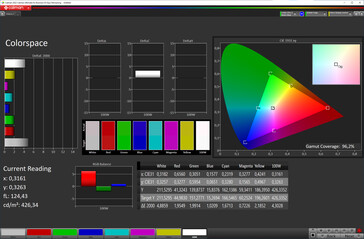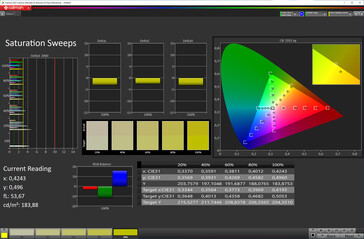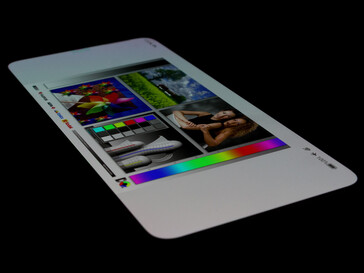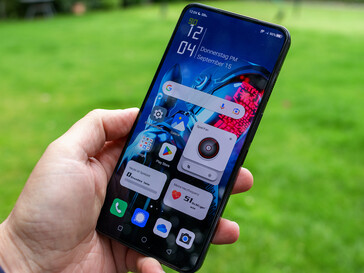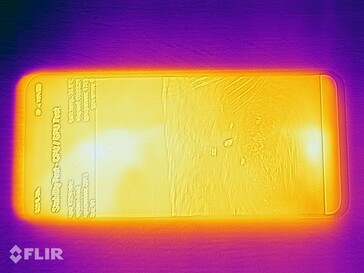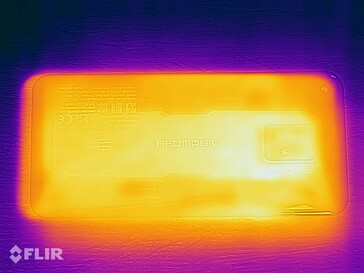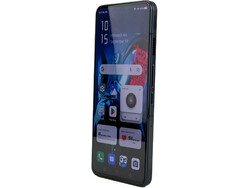Nubia RedMagic 7S Pro review - The gaming smartphone with integrated fan and UDC
Possible competitors in comparison
Rating | Date | Model | Weight | Drive | Size | Resolution | Price |
|---|---|---|---|---|---|---|---|
| 84.9 % v7 (old) | 09 / 2022 | Nubia RedMagic 7S Pro SD 8+ Gen 1, Adreno 730 | 235 g | 256 GB UFS 3.1 Flash | 6.80" | 2400x1080 | |
| 89.5 % v7 (old) | 01 / 2023 | Asus ROG Phone 6 Pro SD 8+ Gen 1, Adreno 730 | 239 g | 512 GB UFS 3.1 Flash | 6.78" | 2448x1080 | |
| 85.7 % v7 (old) | 06 / 2022 | Xiaomi Black Shark 5 Pro SD 8 Gen 1, Adreno 730 | 220 g | 256 GB UFS 3.1 Flash | 6.67" | 2400x1080 | |
| 85 % v7 (old) | 03 / 2022 | Nubia RedMagic 7 SD 8 Gen 1, Adreno 730 | 226 g | 256 GB UFS 3.1 Flash | 6.80" | 2400x1080 |
Housing and features - 960 Hz sampling rate in the RedMagic 7S Pro
The Nubia RedMagic 7S Pro is available in three designs: Obsidian, Supernova and Mercury. The three variants differ both visually and in terms of memory configuration. The cheapest Obsidian model (779 Euros/~$780, our review sample) offers a slightly reduced configuration and does not have a visible LED fan. Mercury (949 Euros/~$950) looks very similar, but offers a small window on the illuminated fan and a generous 18 GB of RAM and 512 GB of internal storage. Supernova (949 Euros) is identical to Mercury in terms of features, but has a bright, grayish design.
The smartphone's build quality is really good. The gaps are even and tight. The material feel is also decent, only the keys have a bit of play, which spoils the good impression a bit. The sensor keys of the RedMagic smartphone can be felt easily and are a useful addition to the game controls. The slide button on the opposite side puts the smartphone into a gaming mode with its own interface, via which games can be accessed directly and settings can be adjusted individually. The increased sampling rate of 960 Hz has to be enabled in the settings first, otherwise the touchscreen only works with 480 Hz. The control of the rear LEDs is also found here.
Communication, software and operation - Fingerprint with pulse measurement
The RedMagic 7S Pro nominally supports Wi-Fi 6E, but it did not want to find the 6 GHz network in combination with our reference router Asus Rapture GT-AXE11000, and the transmission rates on the 5 GHz frequency are very slow for Wi-Fi 6. For accessing the mobile data network, the RedMagic offers a solid configuration including 5G Sub6, which supports all important bands for Europe.
The voice quality is rather average. When held to the ear, it is okay, but could be a bit clearer. The suppression of ambient noise is rather mediocre. The speaker also reverberates audibly and the microphone range is short. Features like VoLTE and Wi-Fi calls are supported.
Google Android 12 with the RedMagic OS 5.5 user interface is used as the operating system. Apart from the Google apps, Nubia does not install third-party applications. Despite an interim update, the security patches are just up to June 1, 2022, and thus no longer up-to-date. The manufacturer does not make any concrete statements about the supply of updates. We rather expect irregular security patches and a maximum of one major upgrade.
An optical fingerprint sensor in the display is available for biometric security. It unlocks the RedMagic very quickly and has reliable recognition rates. Furthermore, a pulse measurement can also be performed via this. Face recognition via the front-facing camera is additionally or alternatively available.
| Networking | |
| iperf3 transmit AXE11000 | |
| Asus ROG Phone 6 Pro | |
| Nubia RedMagic 7S Pro | |
| Nubia RedMagic 7 | |
| iperf3 receive AXE11000 | |
| Asus ROG Phone 6 Pro | |
| Nubia RedMagic 7S Pro | |
| Nubia RedMagic 7 | |
| iperf3 transmit AXE11000 6GHz | |
| Asus ROG Phone 6 Pro | |
| Xiaomi Black Shark 5 Pro | |
| iperf3 receive AXE11000 6GHz | |
| Asus ROG Phone 6 Pro | |
| Xiaomi Black Shark 5 Pro | |
Cameras - RedMagic 7S Pro with three lenses and UDC
The main sensor of the triple camera system is a Samsung GW3. It enables good photos, which, however, have a rather cool white balance in practice and are sharpened considerably by the software. The ultra-wide-angle lens only has a few details and cannot really convince. The third lens is probably only used to determine depth information, but Nubia does not provide any concrete information in this regard.
The under-display camera (UDC) in the panel can be seen well when looking at the screen from the side, otherwise it is almost invisible. The imaging performance is certainly not outstanding for social media and messaging, but it is still sufficient. Videos are only recorded in Full HD, but motion pictures in 8K are also possible with the main camera.
Image comparison
Choose a scene and navigate within the first image. One click changes the position on touchscreens. One click on the zoomed-in image opens the original in a new window. The first image shows the scaled photograph of the test device.
Main cameraMain cameraUltra wide-angle5x ZoomLow-Light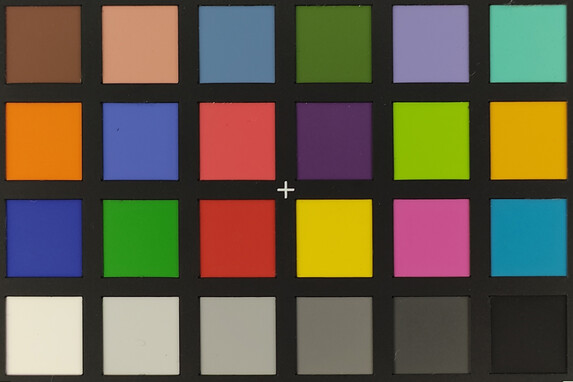
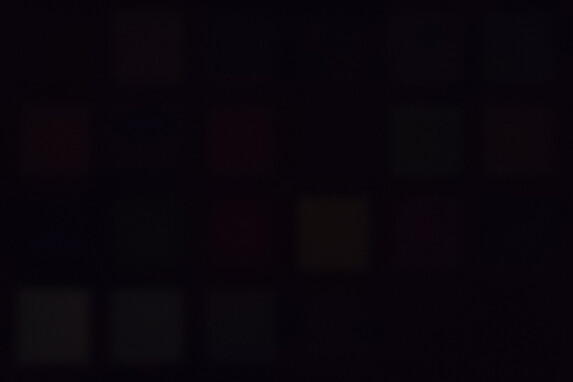
Display - 120 Hz only for gaming
The AMOLED display is just as big as in the RedMagic 7, but it is not quite as bright and only works with up to 120 Hz. The brightness averages 627 cd/m² with the ambient light sensor enabled; a maximum of 464 cd/m² is possible with manual control. With an even distribution of bright and dark areas (APL18), up to 811 cd/m² are achieved. This is sufficient for an appealing display of HDR content, but the RedMagic 7S Pro only supports HLG and HDR10.
The refresh rate is specified by the manufacturer with up to 120 Hz and can be fixed to either 60, 90 or 120 Hz in the settings. If the highest value is selected, the system still works with 90 Hz, and the 120 Hz is only enabled in games.
As with all OLEDs, the RedMagic 7S Pro's also flickers. At minimum display brightness, the period is very unsteady and flickers between 180 and 801 Hz. Above 46% of the panel brightness, we can only measure the refresh rate at 90 Hz. If you activate the DC dimming mode, you get a constant 90 Hz. We cannot determine temporal dithering. For this, we looked at the display with a microscope and a 240 FPS slow motion video (dark gray, at full brightness).
| |||||||||||||||||||||||||
Brightness Distribution: 91 %
Center on Battery: 618 cd/m²
Contrast: ∞:1 (Black: 0 cd/m²)
ΔE ColorChecker Calman: 2.9 | ∀{0.5-29.43 Ø4.77}
ΔE Greyscale Calman: 4 | ∀{0.09-98 Ø5}
96.2% sRGB (Calman 2D)
Gamma: 2.35
CCT: 6098 K
| Nubia RedMagic 7S Pro AMOLED, 2400x1080, 6.8" | Asus ROG Phone 6 Pro AMOLED, 2448x1080, 6.8" | Xiaomi Black Shark 5 Pro AMOLED, 2400x1080, 6.7" | Nubia RedMagic 7 AMOLED, 2400x1080, 6.8" | |
|---|---|---|---|---|
| Response Times | 21% | -444% | 24% | |
| Response Time Grey 50% / Grey 80% * (ms) | 1.27 ? | 1.042 ? 18% | 6 ? -372% | 0.912 ? 28% |
| Response Time Black / White * (ms) | 1.3 ? | 0.998 ? 23% | 8 ? -515% | 1.038 ? 20% |
| PWM Frequency (Hz) | 801 | 672.1 | 235 | 729 |
| Screen | 28% | -8% | -7% | |
| Brightness middle (cd/m²) | 618 | 860 39% | 642 4% | 683 11% |
| Brightness (cd/m²) | 627 | 868 38% | 637 2% | 685 9% |
| Brightness Distribution (%) | 91 | 97 7% | 96 5% | 95 4% |
| Black Level * (cd/m²) | ||||
| Colorchecker dE 2000 * | 2.9 | 2.4 17% | 3.19 -10% | 3.6 -24% |
| Colorchecker dE 2000 max. * | 5.7 | 3.9 32% | 7.12 -25% | 6.7 -18% |
| Greyscale dE 2000 * | 4 | 2.5 37% | 4.9 -23% | 5 -25% |
| Gamma | 2.35 94% | 2.08 106% | 2.22 99% | 2.14 103% |
| CCT | 6098 107% | 6640 98% | 7671 85% | 7537 86% |
| Total Average (Program / Settings) | 25% /
26% | -226% /
-117% | 9% /
1% |
* ... smaller is better
Display Response Times
| ↔ Response Time Black to White | ||
|---|---|---|
| 1.3 ms ... rise ↗ and fall ↘ combined | ↗ 0.675 ms rise | |
| ↘ 0.6275 ms fall | ||
| The screen shows very fast response rates in our tests and should be very well suited for fast-paced gaming. In comparison, all tested devices range from 0.1 (minimum) to 240 (maximum) ms. » 6 % of all devices are better. This means that the measured response time is better than the average of all tested devices (20.2 ms). | ||
| ↔ Response Time 50% Grey to 80% Grey | ||
| 1.27 ms ... rise ↗ and fall ↘ combined | ↗ 0.571 ms rise | |
| ↘ 0.698 ms fall | ||
| The screen shows very fast response rates in our tests and should be very well suited for fast-paced gaming. In comparison, all tested devices range from 0.165 (minimum) to 636 (maximum) ms. » 5 % of all devices are better. This means that the measured response time is better than the average of all tested devices (31.6 ms). | ||
Screen Flickering / PWM (Pulse-Width Modulation)
| Screen flickering / PWM detected | 801 Hz | ||
The display backlight flickers at 801 Hz (worst case, e.g., utilizing PWM) . The frequency of 801 Hz is quite high, so most users sensitive to PWM should not notice any flickering. In comparison: 53 % of all tested devices do not use PWM to dim the display. If PWM was detected, an average of 8084 (minimum: 5 - maximum: 343500) Hz was measured. | |||
Measurement series with fixed zoom level and different brightness settings
Performance, emissions and battery life
The RedMagic 7S Pro in our test version relies on a Snapdragon 8+ Gen 1 with Adreno 730 and 12 GB LPDDR5 RAM. There are no restrictions when navigating through the system or when gaming. Especially when gaming, the fan, which spins at up to 20,000 RPM, ensures almost stable frame rates, but is also quite loud with up to 45 dB(A).
The two speakers have a clean sound reproduction, as long as they are not set too loud, then the treble-heavy sound is more negatively noticeable and sounds a bit hollow. The audio jack (SNR: 86.10 dBFS) is a good alternative and those who prefer to use Bluetooth have a wide audio codec support (SBC, AAC, aptX, aptX HD, aptX Adaptive, aptX TWS+, LDAC) at their disposal.
The battery is larger than the sister model with 5,000 mAh, and Nubia accordingly manages to generate more runtime from this advantage. However, one day of use should still be possible with one battery charge.
| Nubia RedMagic 7S Pro | Asus ROG Phone 6 Pro | Xiaomi Black Shark 5 Pro | Nubia RedMagic 7 | Average 256 GB UFS 3.1 Flash | Average of class Smartphone | |
|---|---|---|---|---|---|---|
| AndroBench 3-5 | 19% | 20% | -3% | -2% | 21% | |
| Sequential Read 256KB (MB/s) | 1822.05 | 1949.16 7% | 1945.4 7% | 1750 -4% | 1757 ? -4% | 2235 ? 23% |
| Sequential Write 256KB (MB/s) | 1258.69 | 1454.5 16% | 1485.2 18% | 1260 0% | 1204 ? -4% | 1871 ? 49% |
| Random Read 4KB (MB/s) | 327.23 | 297.48 -9% | 344.9 5% | 306.2 -6% | 287 ? -12% | 297 ? -9% |
| Random Write 4KB (MB/s) | 287.63 | 459.66 60% | 424.8 48% | 282.5 -2% | 318 ? 11% | 343 ? 19% |
Temperature
(+) The maximum temperature on the upper side is 35.4 °C / 96 F, compared to the average of 35.2 °C / 95 F, ranging from 21.9 to 247 °C for the class Smartphone.
(+) The bottom heats up to a maximum of 33.4 °C / 92 F, compared to the average of 34 °C / 93 F
(+) In idle usage, the average temperature for the upper side is 31.9 °C / 89 F, compared to the device average of 32.9 °C / 91 F.
Speaker
Nubia RedMagic 7S Pro audio analysis
(+) | speakers can play relatively loud (88.3 dB)
Bass 100 - 315 Hz
(-) | nearly no bass - on average 27% lower than median
(±) | linearity of bass is average (10% delta to prev. frequency)
Mids 400 - 2000 Hz
(±) | higher mids - on average 5.6% higher than median
(+) | mids are linear (6% delta to prev. frequency)
Highs 2 - 16 kHz
(+) | balanced highs - only 4.5% away from median
(+) | highs are linear (4.3% delta to prev. frequency)
Overall 100 - 16.000 Hz
(±) | linearity of overall sound is average (20% difference to median)
Compared to same class
» 32% of all tested devices in this class were better, 9% similar, 60% worse
» The best had a delta of 11%, average was 35%, worst was 134%
Compared to all devices tested
» 50% of all tested devices were better, 8% similar, 41% worse
» The best had a delta of 4%, average was 24%, worst was 134%
Asus ROG Phone 6 Pro audio analysis
(+) | speakers can play relatively loud (93.3 dB)
Bass 100 - 315 Hz
(-) | nearly no bass - on average 22.6% lower than median
(+) | bass is linear (3.9% delta to prev. frequency)
Mids 400 - 2000 Hz
(+) | balanced mids - only 4.7% away from median
(+) | mids are linear (3.9% delta to prev. frequency)
Highs 2 - 16 kHz
(+) | balanced highs - only 2.7% away from median
(+) | highs are linear (3.2% delta to prev. frequency)
Overall 100 - 16.000 Hz
(±) | linearity of overall sound is average (15.5% difference to median)
Compared to same class
» 4% of all tested devices in this class were better, 3% similar, 93% worse
» The best had a delta of 11%, average was 35%, worst was 134%
Compared to all devices tested
» 22% of all tested devices were better, 4% similar, 74% worse
» The best had a delta of 4%, average was 24%, worst was 134%
Battery life
| Battery Runtime - WiFi Websurfing | |
| Average of class Smartphone (12.1 - 54.1, n=208, last 2 years) | |
| Asus ROG Phone 6 Pro | |
| Xiaomi Black Shark 5 Pro | |
| Nubia RedMagic 7S Pro | |
| Nubia RedMagic 7 | |
Pros
Cons
Verdict - Fast gamer with a loud fan
The Nubia RedMagic 7S Pro is a good gaming smartphone, but it is a bit user-unfriendly in some places. If you want to use the 960 Hz sampling rate for the touchscreen, you have to activate it first, and you also have to set the higher refresh rate first. It is also a pity that the navigation in the system is limited to 90 Hz.
However, if you are looking for pure performance and do not want to lug around a clunky plug-on fan, the RedMagic smartphone is the right choice, but you will have to put up with a loud, high-frequency fan. However, it manages very good long-term performance. The 520 Hz sensor keys are also a useful addition and work well.
The RedMagic 7S Pro offers a lot of performance and a cool gaming look.
However, the 7S Pro has to accept criticism for its Wi-Fi speed. The nominal Wi-Fi 6E neither supports the 6 GHz network nor is it particularly fast. The update supply is also uncertain; there are no concrete statements from the manufacturer in this regard.
Strong gaming alternatives without an integrated fan are the Black Shark 5 Pro and especially the class leader ROG Phone 6 Pro.
Price and availability
The RedMagic 7S Pro can be purchased directly from the manufacturer's store at https://eu.redmagic.gg/de/products/redmagic-7s-pro but is also available from Amazon.
Nubia RedMagic 7S Pro
- 09/15/2022 v7 (old)
Daniel Schmidt




